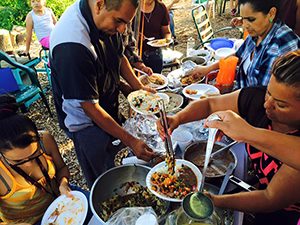Community gardens serve as a place-based tool for connection, empowerment, and cultural identity.
Today, more gardens are popping up in school yards, in vacant lots, nonprofits, and housing developments. Educators are using gardens as creative and holistic tools for teaching beyond the walls of the classroom.
In 2014, I wrote the piece, Using Gardens as Classrooms and shared how educators can use garden-based learning in formal and informal education settings with resources related to academic enrichment, family and community connections, storytelling, intergenerational relationships, and ecological sustainability. As I continue in my work with community gardens and youth programs in my own community, I came across an article by Margaret Lamar from the Children and Nature Network.
She eloquently shares that, “natural green spaces are only part of a very complex set of solutions to our divisions, but perhaps they can provide some of the conditions for our coming together–to know one another, to see each other, to tell our stories, and to learn to live and thrive together.” She next poses ten questions for educators to consider as we use nature as a tool for change. Today, I will use two of her questions to shape the resources shared in this post:
Question 4: How can we use nature or outdoor programming to encourage cross-cultural exchange and community-based youth leadership?
Question 9: How can the smallest community gardens and the largest botanical gardens foster connections among cultural traditions, food, and multi-generational wisdom?
Neighborhood Engagement
Because gardens produce vibrant and tasteful foods, one idea to celebrate the diversity of your community is to hold a garden feast. During this event, you can invite members of your community to bring a fresh dish from their culture. Provide conversation starters on tables that encourage cross-cultural exchange. In addition to the meal, you can plan music, art, or wellness activities that connect to different heritages. The Regional Park District in Oakland, CA set a good example for the intentionality of bringing community groups together by holding multicultural wellness walks and trail days.
 Or, if you are doing a garden feast as a part of your school or out-of-school program, here a few ideas to try:
Or, if you are doing a garden feast as a part of your school or out-of-school program, here a few ideas to try:
- Design a cooking club and have students work together to prepare a menu with fresh ingredients from the garden with the culminating event being a community feast.
- Take a field trip to an ethnic market. Have students record foods and products that they are unaware of and later research how the different plants and foods they discovered are used in different cultures. Design a list of questions that can be used to spark conversation with shop owners.
- Finally, have students sample foods. If you don’t have access to a local ethnic food market, utilize a virtual field trip or use Google Maps to explore markets from around the world.
- A great resource to use, especially if your youth program does not have a garden, is Nature Works Everywhere’s Community Garden video and lesson plan. This plan will guide you through community engagement steps.
Garden Mosaics
Food and Nutrition/Food Security
- Create partnerships between schools and out-of-school-time programs so that the food gap is filled for low-income families when school is out.
- Visit these programs – Real Food Rising, Urban Roots Austin, and The Food Project – for examples of how communities are combining youth leadership and food access.
- Additional resources for Garden-Enhanced Nutrition Education (GENE) can be found at the Collective School Garden Network.
Global ArgiBusiness
- Ask students to visually track where a specific food product comes from when they purchase it from the grocery store.
- Use the story Westlandia as a starting point for a lesson about how agriculture connects with development, jobs, and community roles.
Art
- Do you know that you can grow your own instrument? You can! This blog shares multiple ways to use a gourd to create musical instruments from around the world. Invite students to make an instrument and then learn some rhythms together.
- Read the book, The Global Garden, and have students create their own pop-up book, using each page to showcase foods from around the world.
- Paint a mural with a peace theme, using different languages and images.
My hope is that these resources can empower your education community to use gardens as a place where the exchange of culture comes to life and participants continue to see the world through all lenses. The ideas are endless! Everything from a pumpkin exchange to a community garden feast can build social connection and capital, increase skills and knowledge, improve our mental and physical welfare, and can be a positive tool for change.
For breakfast, I had hard boiled eggs, a banana, and iced coffee.
Author: @kristinstayer
